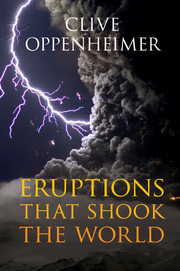Book contents
- Frontmatter
- Contents
- Preface
- Acknowledgements
- 1 Fire and brimstone: how volcanoes work
- 2 Eruption styles, hazards and ecosystem impacts
- 3 Volcanoes and global climate change
- 4 Forensic volcanology
- 5 Relics, myths and chronicles
- 6 Killer plumes
- 7 Human origins
- 8 The ash giant/sulphur dwarf
- 9 European volcanism in prehistory
- 10 The rise of Teotihuacán
- 11 Dark Ages: dark nature?
- 12 The haze famine
- 13 The last great subsistence crisis in the Western world
- 14 Volcanic catastrophe risk
- Appendix A Large eruptions
- Appendix B Further reading and data sources
- References
- Index
10 - The rise of Teotihuacán
Published online by Cambridge University Press: 01 June 2011
- Frontmatter
- Contents
- Preface
- Acknowledgements
- 1 Fire and brimstone: how volcanoes work
- 2 Eruption styles, hazards and ecosystem impacts
- 3 Volcanoes and global climate change
- 4 Forensic volcanology
- 5 Relics, myths and chronicles
- 6 Killer plumes
- 7 Human origins
- 8 The ash giant/sulphur dwarf
- 9 European volcanism in prehistory
- 10 The rise of Teotihuacán
- 11 Dark Ages: dark nature?
- 12 The haze famine
- 13 The last great subsistence crisis in the Western world
- 14 Volcanic catastrophe risk
- Appendix A Large eruptions
- Appendix B Further reading and data sources
- References
- Index
Summary
Plinian ash falls, as opposed to lava flows or surges, provide the most interesting prospects for archaeology: When the column of tephra rises high into the atmosphere from the crater and then collapses over the landscape, the pumitic material blankets the agricultural fields, buildings, and activity areas in a way that effectively preserves them for future study. The local inhabitants flee, some with more luck than others, and in their haste they often leave behind many of their household goods, providing archaeologists with an impressive array of primary contexts that are particularly relevant to … understanding past lifeways.
P. Plunket and G. Uruñuela, Latin American Antiquity, 1998 [177]Teotihuacán – now located some 45 kilometres from México City – was one of the greatest cities of the ancient world, rising in the first or second centuries BCE and lasting into the seventh or eighth century CE. At its apogee in the fourth century CE it was home to around 125,000 people and covered an area of 30 square kilometres. By the third century CE, a construction boom had established an astonishing complex of pyramids – including the Sun and Moon pyramids, and the Pyramid of the Feathered Serpent. Despite this grandeur, we know rather little about the society that built and sustained this extraordinary civilisation, in part because, unlike the contemporary Mayan glyphs, the inscriptions found at Teotihuacán have yet to be deciphered.
- Type
- Chapter
- Information
- Eruptions that Shook the World , pp. 240 - 252Publisher: Cambridge University PressPrint publication year: 2011



